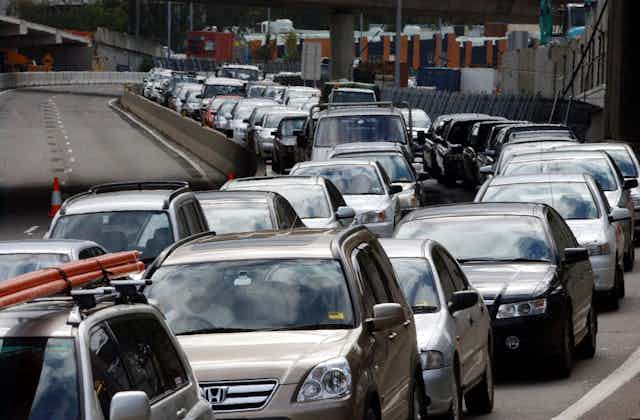Transport modelling for major road projects like Sydney’s WestConnex and Melbourne’s Western Distributor is at odds with what is known about motorists’ behaviour.
A big part of the benefits claimed for new major roads in Australian cities is travel time savings. Evidence shows, however, that instead of saving travel time, these roads encourage us to travel further and often increase car dependency.
Travel time savings (calculated by transport models) have been used in transport project assessment since the 1960s and are often the main justification for projects. These models assume people try to minimise the “generalised cost” of travel (a combination of money cost and the dollar value of time). UK transport researcher David Metz notes that this assumption “is consistent with the idea that travellers take advantage of improved infrastructure to save time”.
Standard economic theory assumes people are motivated to obtain the maximum satisfaction (economists call it “utility”) from the consumption of the goods or services they can afford. This implies they are also motivated to keep the costs associated with that consumption to a minimum.
Where travel is concerned, motorists are assumed to minimise the generalised cost of that travel. Transport models use this approach to calculate travel time savings from new transport infrastructure.
A recent review of research, however, shows that people have a certain amount of time they are prepared to spend travelling each day. This means they don’t take advantage of added infrastructure to save time.
While new roads may reduce travel time for a period on some routes, in the longer run, these savings are spent on travelling further. This means the travel time savings put forward by proponents for these plans are not backed up by real world evidence.
As a result, these assumptions should not be relied upon for the assessment of road projects like WestConnex and the Western Distributor. For WestConnex, the value of calculated travel time savings is A$13 billion, or about half the claimed benefits for the project. Without these time savings, the costs of the project exceed the benefits.
Melbourne researchers John Odgers and Nicholas Low found that the forecast time savings for Melbourne’s CityLink project did not eventuate. They suggest that, rather than being based on evidence, transport policy is probably driven by political momentum to build more roads, because that’s what Australia has been doing for a long time.
Governments and their technical advisers also have strong incentives to find benefits to justify what politicians want to do.
Partly in recognition of the problems with transport modelling, some European cities have changed the way the problem is framed – from meeting forecast travel demand, to achieving a number of social and economic objectives through transport investment. Through sustainable urban mobility plans, different types of projects are favoured. These include: better integrated bus networks, more bus lanes, safer cycling and walking routes, improved park and ride facilities, and traffic calming measures that redesign streetscapes and reduce speed limits to improve mobility for all road users.
Rather than facilitating the movement of motor vehicles, this process emphasises creating safe, reliable and affordable access with less travel and a reduced environmental footprint. It also requires that engineers, urban planners, economists and other specialists sit down with the business and community sectors to build a consensus on what needs to be done. This is in contrast to current engineering-dominated methods.
In Australia, the Delivering Sustainable Urban Mobility report prepared for the federal government emphasises “putting people first” in urban transport. The report recommends a three-part approach: less travel, shifting away from trips by car, and improving vehicle fuel efficiency.
While this is somewhat encouraging, there is no recognition in the report that current methods of calculating the benefits of roads projects are unreliable because of the way time savings are calculated.
Despite a lack of evidence, the use of travel time savings calculated in transport models is deeply entrenched in government and professional practice. Until this flawed approach is replaced by something like sustainable urban mobility plans, government road spending will continue to encourage sprawl and car dependency, rather than save us time.
Urban planner Brian Feeney substantially contributed to this piece.

